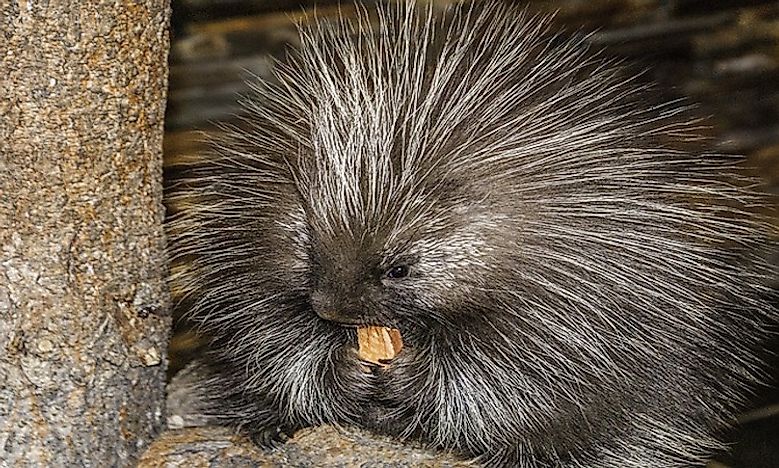


If you see this happening to a tree you want to save, you can try putting an exclosure around the tree, like some smooth tin wrapped around the trunk. Porcupines like to pick a favorite tree, called a loafing tree, and slowly kill it by munching off the bark. Quills are an effective deterrent for most porky predators, with the exception of vehicles, which seem to have no trouble killing them as they bumble across roads at night. Bobcats also eat them, as do owls and a couple other predators, but sometimes these predators are mortally injured by their prey. The fisher is well-known for its ability to slowly and painfully kill a porcupine, flip it over, and eat it from the stomach, where there are no quills. There are still some predators that focus on eating porcupine. The result is a painful distraction that allows the porcupine to move away from its attacker. When an animal touches a quill, the tip sticks in the skin, the tiny scales grab on and hold it there, and the spongy air-filled shaft swells with the added body heat of the victim. However, the quills are not thrown or ejected by the porcupine. In fact, some might even fall off if the animal shakes or jumps, giving the illusion that the quill was thrown. This loosens the skins grip on the quills, making them easier to pull off. When the porcupine feels threatened, it turns its back and rump toward its attackers and tightens a special muscle under the skin. The shaft of the quill is spongy and somewhat hollow. Porcupines are best known for their quills, actually a kind of modified hair with tiny scaly hooks at the tip and base. They also like to eat green plants like skunk cabbage, clover, and lupine during the growing season. They are mostly nocturnal this is primarily because they feed on leaves, twigs, and bark, and the best materials and nutrients are available at night when the tree is not actively photosynthesizing. Porcupines have a very good sense of smell, but very poor vision.

The female porcupine gives birth to one offspring a year, called a porcupette, born headfirst, with soft quills that don’t harden until after the baby is born. In the wild, a porcupine might live six years, which is actually quite long for a rodent in captivity, they can live up to 18 years. The North American porcupine is unique among these subspecies because it is the only one in the world adapted to cold winter temperatures. In Wisconsin, we only have one porcupine species-the North American Porcupine. There are 27 varieties of porcupine located around the world.
Are porcupines nocturnal full#
A full grown adult porcupine can reach 30 inches long and weigh 30 pounds. Porcupines are the second largest rodent in North America, the beaver being the largest. We also noticed that one animal that seemed to be bad at safely crossing roads was the porcupine. On a recent family outing, we noticed that wildlife is on the move taking advantage of what’s shaped up to be an early spring.

The Masked Biologist wants to help you get to know the porcupine and maybe share some tips or tricks to reduce porcupine damage in this week’s Wildlife Matters. Porcupines gnaw salty objects, tools and wooden buildings, and may damage corn or alfalfa.A common resident of the Northwoods, the porcupine is often the source of much frustration and consternation for forest managers and homeowners. Some trees are damaged but extensive harm to forests is rare. Food, cut by 4 chisel-shaped incisors, is ground by 16 ridged cheek teeth. They eat bark, buds, and the leaves and twigs of trees and other PLANTS. Usually solitary, porcupines sometimes share good dens or feeding areas. Porcupines are usually nocturnal and do not hibernate. It soon walks and climbs, is weaned within 10 days, and leaves its mother by fall. One young is born 7 months after fall mating. Slow-moving porcupines are vulnerable to automobiles and fires. MAMMAL predators (eg, FISHERS, WOLVERINES) avoid the quills by attacking the almost quill-free head. Quills are easily dislodged from the porcupine's skin, but cannot be thrown. When cornered, a porcupine erects its quills and lashes its tail. Of the world's 23 species, only the N American porcupine ( Erethizon dorsatum) occurs in Canada, throughout mainland FORESTS and thickets.Ĭanada's second-largest RODENT (up to 18 kg and 103 cm long, including a 30 cm tail) has a stout, black and yellowish white body bearing 30 000 sharp, slightly barbed quills (up to 8 cm long) on upper parts and tail.


 0 kommentar(er)
0 kommentar(er)
